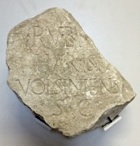The civic archeological collection is in two parts:
-
✴a number of inscriptions are embedded in the walls around the staircase in the Museo Civico; and
-
✴the museum itself is on the second floor.
Staircase
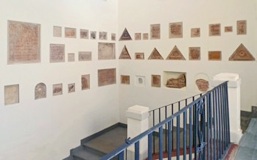
The walls of the staircase are encrusted with ancient artefacts (mostly inscriptions) that were originally assembled in Palazzo dei Consoli in the late 18th century. The following are the most interesting of these, numbered from the guide written by Carlo Pietrangeli (referenced below, 1985).
Cult of Valetudo
A large number of inscriptions from Bevagna relate to a magistracy known as the magistri or novemviri Valetudinis (discussed below), a title that is not known anywhere else. This magistracy was presumably associated with the goddess Valetudo, although there is only one surviving record from Bevagna that (probably) refers directly to her (see ‘Valetudo [25]’ below). See also the relevant inscriptions in the Museo Archeologico, below.
Valetudo [25]
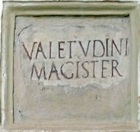
“VALETUDIN[...]/ MAGISTER”
According to Giuseppina Prosperi Valenti (referenced below, 2005, at p. 42), it was part of a dedication to the goddess (whose name is given in the dative) by a now-anonymous magister, presumably a magister Valetudinis (see below)
Sacred Roads Paved by the Magistri Valetudinis
Two important inscriptions in the museum, both of which probably date the the early part of the reign of the Emperor Augustus (27 BC - 14 AD), record the paving of what were presumably processional roads by the magistri Valetudinis. The urban/religious context of these roads is described in the page on cult sites of Bevagna. One of these (CIL XI 5040) is here and the other (CIL XI 5041) is in the museum proper (see below).
Inscription from San Silvestro [96]
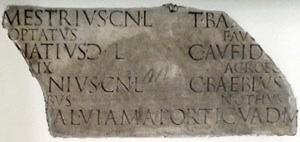
This fragmentary inscription (CIL XI 5040) relates to another paving project that had been financed by the magistri/ novemviri Valetudinis. According to Giuseppina Prosperi Valenti (referenced below, 2005, entry 3), they were found in ca. 1876 behind the church of San Silvestro (see Walk I). The surviving fragments records the names of six freedmen in two columns: it seems likely that there were originally three columns and a total of nine names. The surviving names are:
-
✴on the left:
-
•[C]n(aeus) Mestrius Cn(aei) l(ibertus) Optatus;
-
•C(aius) Egnatius C(ai) l(ibertus) Felix;
-
•Cn(aeus) [- - -]anius Cn(aei) l(ibertus) [- - -]bus; and
-
✴on the right:
-
•T(itus) Bae[bius T(iti) l(ibertus)] Faus[tus];
-
•C(aius) Aufidi[us C(ai) l(ibertus)] Agroec[us], who is known from another inscription that is now in the Museo Civico, Montefalco; and
-
•C(aius) Baebius [C(ai) l(ibertus)] Nothus.
The surviving part of the last line of the inscription has been completed as:
[VIIII viri] Val(etudinis) viam a porticu ad m[....... straverunt]
Thus, assuming that this completion is correct, the novemviri Valetudinis had paved a section of a street or road from a portico to a place beginning with ‘m’:
-
✴The original CIL entry, followed by Prosperi Valenti (as above) and by the EAGLE database (see the CIL link), completed m[.......] as m[acellum] (market).
-
✴However, Simone Sisani (referenced below, 2012, p. 443, entry 2:4) suggested m[iliarium] (milestone) and further suggested that this was a second ceremonial road, which ran from Porta Todi (see Walk II) towards Spoletium, probably terminating at the cult site at the source of the Clitumnus.
There is also uncertainty about the date of the inscription:
-
✴Simone Sisani (2012, referenced below, at p. 420) considered it to be broadly contemporary with CIL XI 5041 (above) - i.e. he dated it to ca. 27 BC.
-
✴The EAGLE database (see the CIL link) gives a later date, in the first half of the 1st century AD.
Other Inscriptions
Lid of a cinerary urn (late 2nd century BC)

C(aius) Laaro V(ibii) f(ilius) T(iti) n(epos)
Caius Laaro, son of Vibius, grandson of Titus
This inscription, which is from an unknown location in Bevagna, is also described on the page Latin Inscriptions after 295 BC.
Inscription [??]
This fragmentary inscription (CIL XI 5062, 1st century AD) from an unknown location in Bevagna reads:
[ob ho]nor[em ---]
[--- edid]ìt inpen[sa sua]
[--- munus g]ladiato[rium ---]
It relates to the financing of gladiatorial contests, presumably in the amphitheatre.
Inscription [13]
This inscription (CIL XI 5024, from the period 30-70 AD), which was found under Piazza Silvestri , reads:
[--- ]mo/ [--- M]inerv(ae)
[---] donatum/ [--- et F]ortunata Clari 〈:uxor〉
[--- f]abricaverụ(nt)
It seems to relate to a temple or statue of Minerva that had been commissioned by a married couple.
Inscription (late 1st century AD) [12]
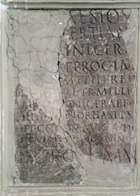
SEX(TO) CAESIO SEX(TI) [F(ILIO)] / PROPERTIANO
FLAMINI CERIALI
ROMAE PROC(URATORI) IMP(ERATORIS)
A PATRIM(ONIO) ET HEREDIT(ATIBUS)
ET A LI[B]ELL(IS) TR(IBUNO) MIL(ITUM) LEG(IONIS) IIII
MACEDONIC(AE) PRAEF(ECTO) COH(ORTIS)
III HIS[PA]NOR(UM) HAST(A) PURA
ET CORON(A) AUREA DON(ATO)
IIIIVIR(O) I(URE) D(ICUNDO) IIIIVIR(O) QUINQ(UENNALI) PON(TIFICI)
PATRON(O) MUN(ICIPII)
From this, it emerges that Sextus Caesius Propertianus held a number of important posts, which included: Flamen Cerialis (a priest assigned to the goddess Ceres); Miltary Tribune of the Fourth Macedonian Legion; and Prefect of the Third Spanish Cohort. He was also the winner of two high military medals: the Hasta Pura (literally “arrow without a head”); and Corona Aurea (Golden Crown). The Fourth Macedonian Legion was disbanded in 70 AD, so Caesius presumably held his posts of quattuorvir iure dicundo, quattuorvir quìnquennali and pontifex at Mevania thereafter. The EAGLE database (see the CIL link above) dates the inscription to some time during the last three decades of the 1st century AD.
Inscriptions (80 - 130 AD) (17 and 79)
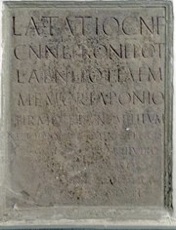
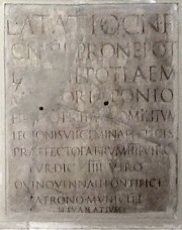
These two versions of an inscription (CIL XI 5033), which are now embedded on opposite walls in the stair well, came from the base of a statue that was discovered in 1723 at Fiamenga. The inscriptions commemorate Lucius Atatius Memor Aponius Firmus, who was Military Tribune of the Legio VII Gemina Felix (7th Legion, Gemina Felix, formed by the Emperor Vespasian). He also held municipal office at Mevania (as quattuorvir iure dicundo, quattuorvir quinquennale and pontifex) and acted as its patron.
Inscription (Date ??) (59)
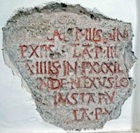
Architectural Fragment (3)
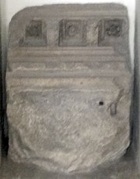
Museo Archeologico
This part of the museum was still in restoration during my visit in June 2017.
Inscribed cippus (2nd century BC)
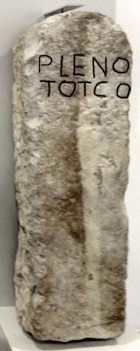
This is one of four essentially identical inscriptions came from different locations around Bevagna:
-
✴The second (CIL XI 5149a), which was found near the amphitheatre, no longer survives.
-
✴The third (EDR 159639), which was found near Sant’ Agostino, also no longer survives.
-
✴The fourth (AE 1965, 0279b), which is embedded in a house (8 Via Veronici) at Gualdo Cattaneo, was discovered there in 1965.
The stones probably marked the boundary of a public area, perhaps associated with the aqueduct or with the municipium itself.
The inscriptions are discussed in context in the page on Umbrian Inscriptions after 295BC.
Inscribed cover of a cinerary urn (ca. 100 BC)

This inscribed cover of a cinerary urn was found in the area of the Fabbrica necropolis (see Walk II). The Umbrian inscription, which uses an Etruscan alphabet, reads:
v(ipi) ia kaltini
It commemorates Vibio Caltinio, the son of Ianto.
This inscription is discussed in context in the page on Umbrian Inscriptions after 295BC.
Aulus Rubrius (1st century BC)
A RUBR[IUS - F.]
HARISPE[X]
VOLSINIENSI[S]
S(ENATUS) C(ONSULTO)
The senate had decreed the posting of this inscription in honour of Aulus Rubrius, a haruspex (a priest who read the future by examining the entrails of sacrificed animals) who was associated in some way with the Etruscan city of Volsinii.
-
✴Laura Bonomi Ponsi (in A. Feruglio et al., referenced below, pp. 86-7; entry 2:122) dated it to the late Republican period (in the light of its epigraphy and the absence of a cognomen).
-
✴The Eagle database (see the AE link above) dated it to the second half of the 1st century BC.
Laura Bonomi Ponsi (as above) pointed out that the name Rubrius is known from three other inscriptions from Mevania (including CIL XI 5041 above) but not in any known from Volsinii. She therefore suggested that Aulus Rubrius was probably from Mevania but had been instructed in the art of haruspicy at Volsinii.
Sextus Baebius (late 1st century BC)
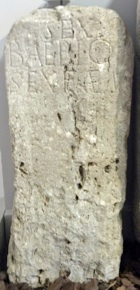
Sex(to) Baebio Sex(ti) f(ilio) Aem(ilia)
This is one of eight known inscriptions that indicate that Mevania was assigned to the Aemilia tribe. No other Umbrian municipium was assigned to this tribe, and it might well have reflected the already-existing assignation of the descendants of viritane settlers at Mevania from perhaps a century earlier than the enfranchisement of the municipium in 90 BC.
Cippus (mid/late 1st century BC)
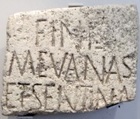
Finis/ Mevanas/ et Sentina(s)
Simone Sisani (referenced below, 2012, at p. 433, note 130) reported that:
-
“... I have been able to inspect the inscription, the paleography of which suggests a dating of the middle of the 1st century BC” (my translation).
He suggested that it indicated extra-territorial possessions of Sentinum in the territory of Mevania. However, it is not absolutely clear that ‘Sentina(s)’ did actually relate to Sentinum. If it did, then it seems to me that, since, according to Cassius Dio, (‘Roman History’, 48: 13: 2-4), Sentinum had revolted against Octavian in 41 BC, any enclaves of land that it retained until then in the Valle Umbra would have been confiscated in the aftermath of Octavian’s victory at Perusia in 40 BC.
Mensa dei Magistri Valetudinis
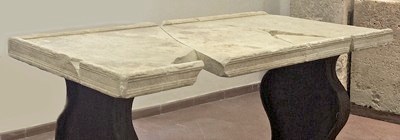
This large marble altar table, which was found outside Porta Foligno (see Walk II), contains an inscription (CIL XI 7926, first half of the 2nd century AD) that associates it with the magistri Valetudinis. The surviving part of the inscription is in two parts:
-
✴The inscription on the left edge of the altar table reads:
-
Mag(istri) Valet(udinis): Q(uintus) Aemilius Q(uinti) l(ibertus) Epaphroditus
-
✴The inscription along the front records the names of six other men:
-
•T(itus) Scetanus T(iti) l(ibertus) Dilige(n)s;
-
•C̲(aius) Publienus C(ai) l(ibertus) Pelops;
-
•T(itus) Egnatius T(iti) l(ibertus) Arsaces;
-
•T(itus) Hedusius T(iti) l(ibertus) Arabus;
-
•C(aius) Lisius C(ai) l(ibertus) Cerdo; and
-
•C(aius) Tettiu[s ] ...
The right side of the altar has been lost, but it is almost certain that its edge was inscribed with the names of the two other men who served in the magistracy at the time. It is possible that the magistri Valetudinis financed the erection of this altar in a public temple in the city, perhaps one dedicated to Valetudo. However, it seems more likely (at least to me) that it came from their meeting place. (I wonder whether the magistri Valetudinis sacrificed at this altar at Mevania, perhaps for the health of the emperor).
Sacred Roads Paved by the Magistri Valetudinis
Two important inscriptions in the museum, both of which probably date the the early part of the reign of the Emperor Augustus (27 BC - 14 AD), record the paving of what were presumably processional roads by the magistri Valetudinis. The urban/religious context of these roads is described in the page on cult sites of Bevagna. One of these (CIL XI 5040) is embedded in the wall of the staircase and the other one (CIL XI 5041) is here.
Via Triumphalis [105]

-
✴[....iu]s [T(iti) l(ibertus) Castus
-
✴[T(itus) ...elius] T(iti) l(ibertus) Phileros
-
✴C(aius) Carpelanus C(ai) l(ibertus) Faustus
-
✴Sex(tus) Rubrius (mulieris)) l(ibertus) Faustus
-
✴[...] Lartius [...] l(ibertus) Salvius
-
✴[...] Cominius [... l(ibertus)] Pylades
The last three lines read:
-
viam triumphalem / straverunt lapide / Hispellate
-
The triumphal way was paved with stone from Spello.
It seems likely that the missing upper part of the inscription recorded:
-
✴the magistri Valetudinis, the magistracy to which all six men almost certainly belonged, which had presumably financed the paving of the road; and
-
✴the names of the three other members of this magistracy.
Simone Sisani (2012, referenced in the page on cult sites of Bevagna - see links above) suggested that this was probably a processional road that ran from the site of the sanctuary in what is now Via I Maggio/ Viale Properzio to a cult site that has been excavated beside the Lago Aisillo, outside Bevagna (see the page on Cult Sites) and then on to what was probably the Roman Sanctuary that has been excavated under Villa Fidelia, outside Spello.
Individual Magistri Valetudinis
C. Attius Dardanus [number ??]
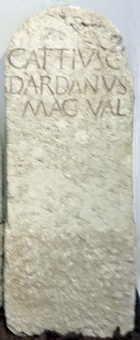
C(aius) Attius C(ai) l(ibertus)/ Dardanus
mag(ister) Val(etudinis)
According to Simone Sisani (referenced below, 2012, at p. 426 and note 93), it dated to the period soon after municipalisation in 90 BC. However, the EAGLE database (see the CIL links above) assigns it to the last three decades of the 1st century BC.
C. Carpelinus Gratus [number ??]
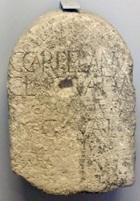
C(aius) Carpelanuṣ/ C(ai) l(ibertus) G̣ṛatus
sagarius [a manufacturer or dealer in woollen cloaks]
mag(ister) Val(etudinis)
According to Simone Sisani (referenced below, 2012, at p. 426 and note 93), it dated to the period soon after municipalisation in 90 BC. However, the EAGLE database (see the AE links above) assigns it to the 1st half of the 1st century AD.
T. Edusius Chrestus [number ??]
A travertine (possibly funerary) stele (CIL XI 7927, 1st half of the 1st century AD) from an unknown location in Bevagna, which is now in the deposit of the museum, commemorates T(itus) Edusius T(iti) l(ibertus) Chrestus, magister Valetudinis, together with a second man whose name is almost lost.
Possible Seviri
A funerary inscription (CIL XI 5051, 31-1 BC) that was found in an unknown location in Bevagna commemorates the free born Titus Eleurius son of Titus, of the Aemilia tribe, as “X(?)vir”, which is sometimes construed as sexvir.
A fragmentary inscription (CIL XI 7929,1st century AD) that was found in Piazza Silvestri (now in the Museo Archeologico) reads:
C(ai-) F+[---]/ VI[---]/ aed[---]
where VI[---] could be completed as VIvir or VIIIIvir. The subject’s post of aedile indicates that he was free born.
Goddess Flora (2nd century AD)
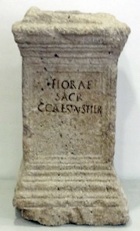
Fragment from a Statue (8)
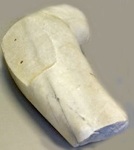
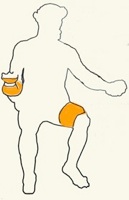
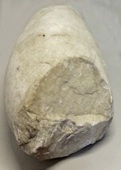
Fragments of an arm and a leg from a colossal statue, probably of a seated male divinity, were found in Parco Silvestri (see Walk II) in 1882. The remains of a temple were found nearby two years later.
Fragment of a Statue (11)

“... IUS THEOPHILUS FECIT”.
The statue dates to the Imperial period.
Finds in Other Museums
Museo Archeologico, Perugia
Bronze discs (7th century BC)
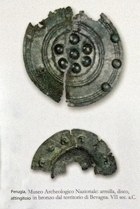
Finds from Viale Properzio (7th – early 6th century BC)
Showcase 15 in the Sala dei Br0nzi contains finds from an archaic settlement that was excavated near the junction of Viale Properzio and Via 1 Maggio in 1980-2. They include:
-
✴an architectural decoration in the form of a gargoyle with the shape of a cat’s head;
-
✴a number of impasto and bucchero pottery fragments; and
-
✴a loom weight.
Antefix (4th century BC)
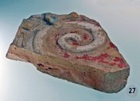
Sundial (ca. 100 BC)
This limestone sundial =in the Sala dei Br0nzi was ploughed up in 1969 near the tabernacle of the Madonna del Core, outside Porta Cannara. The Umbrian inscription on the sundial, which uses an Etruscan alphabet, can be transcribed as:
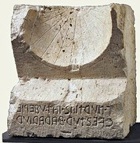
cvestur farariur
[-] P. Nurtins [and] Ia. T. Uferier,
the quaestores of spelt [donated]
The surname of the first magistrate derives from the name of the Etruscan goddess, Nortia. The second transcribes into Latin as Iantus Aufidius, son of Titus. Their magistracy is probably analogous to that of “the two men who come to fetch the flour” for the sacrifice at the annual ritual described in Table Vb of the Iguvine Tables at Gubbio.
There is a copy of this sundial in the Museo Archeologico, Bevagna.
Coin Hoards (211 - 115/ 110 BC)
These hoards of coins in showcase 20 in the Sala dei Br0nzi came from Bevagna.
Hoard from Outside Porta Foligno
A hoard of 911 coins, which included dateable coins from the period 211-115 BC, was found outside Porta Foligno (near the 1st petrol station on the left of SS 316, which follows the line of the Roman Via Flaminia - see Walk II) in 1929. Part of this hoard is n the deposit of the museum at Perugia [check]: unfortunately, the other part, which was originally exhibited locally, was later stolen.
Hoard from Viale Properzio/ Via I Maggio
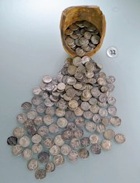
Grave goods from Pilone di Bevagna (ca. 100 AD)
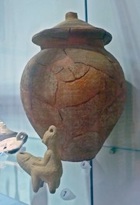
Other Museums
Fragment of a sarcophagus cover (ca. 200 BC)
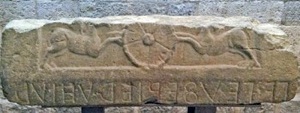
This fragment of a sarcophagus, which came from the necropolis at vigna Boccolini, Bevagna, contains an inscription in Umbrian using an Etruscan alphabet. It refers to the Pe. Pe. Uferier, which the museum translates as the augur Petti di Petto Ofredio. However, the last word is more likely to record that the deceased, Petti di Petto had been a uhter, or magistrate. The fragment is now in the Museo Comunale, Gubbio.
Torso (date?)
This torso from a what was probably a Roman statue of Dionysus was found during the construction of San Filippo Neri in 1725. It was taken to Rome in 1812 and is now in the portico of Palazzo dei Conservatori, part of the Museo Capitolino, Rome.
Statues of Gods (date?)



Asclepius Eros Hercules
These three small statues were probably found in the same Roman domus in Bevagna in the 18th century. They were taken to Rome in 1812 and are now in the Sala delle Colombe, Palazzo Nuovo, part of the Museo Capitolino, Rome.
Read more:
S. Sisani, “I Rapporti tra Mevania e Hispellum nel Quadro del Paesaggio Sacro della Valle Umbra”, in:
G. Della Fina (Ed.), “Il Fanum Voltumnae e i Santuari Comunitari dell’ Italia Antica”, (2012) Orvieto, pp. 409-64
L. Agostiniani et al. (Eds), “Screhto Est: Lingua e Scrittura degli Antichi Umbri”, (2011) Città di Castello
G. Prosperi Valenti, “I Magistri Valetudinis di Mevania” Bollettino della Deputazione di Storia Patria per l’ Umbria, 102:1 (2005) 27-58
A. Feruglio et al. (Eds), “Mevania: Da Centro Umbro a Municipio Romano”, (1991) Perugia
C. Pietrangeli, “Il Museo Archeologico di Bevagna” (1985), available at the museum ticket office
C. Pietrangeli, “Mevania”, (1953) Rome
Return to Museums of Bevagna.
Return to Walk I.


